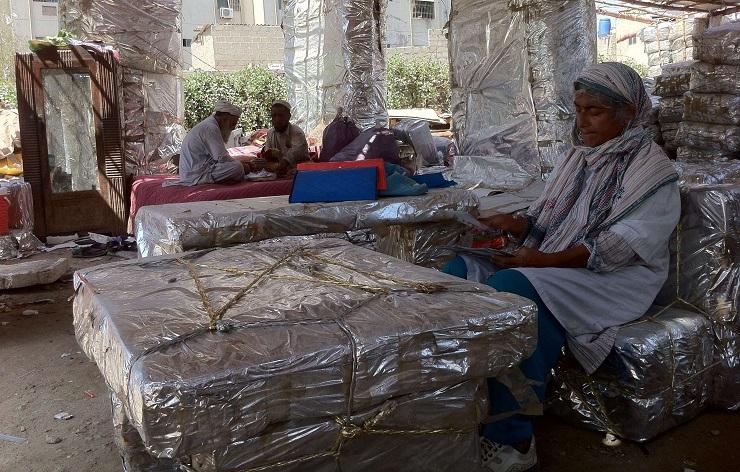ASIACALLING
Innovative recycling in Pakistan, creating shelters, furniture for those in need
"Nargis Lateef has dedicated her life to recycling, and putting to good use, tons of garbage produced in the country’s industrial hub, the city of Karachi. "
Naeem Sahoutara

Do you ever think about how rubbish could be used to make shelters, beautiful furniture or even a swimming pool?
Well, one Pakistani researcher has been working on that challenge for more than two decades.
Nargis Lateef has dedicated her life to recycling, and putting to good use, tons of garbage produced in the country’s industrial hub, the city of Karachi.
Asia Calling correspondent Naeem Sahoutara has this report.
Life moves at a fast pace in Karachi, Pakistan’s economic and industrial hub. The port city is home to 20 million people – and each day waste piles up.
Some 20,000 tons of garbage is produced in the city each day.
That’s Nargis Lateef’s area of expertise. The 63-year-old researcher has been working on the rubbish problem for more than two decades.
Lateef’s workshop resembles something of a junkyard amid a sea of high-rises in the upscale Gulshan-e-Iqbal neighborhood.
Bamboo, cardboard, packing material and other bits of re-used junk are scattered all around.
“I have always worked on those items which nobody else wants to touch,” Lateef tells me.
She recycles everything.
“This started in 1994, I was fed up of the garbage burning in the city, the filth, the waste all over.”
![]()
“The very first year, I did a lot of research. And after all that studying, I came to the conclusion that there was money involved, and that if people could be attracted to this business then people would start dealing in garbage, buying and selling of garbage, then there would be no garbage left.”
“And then I started getting practically involved and I found out that there is a lot of innovation and a lot of new products that could come up, which will change the economy of the country and of the world,” Lateef said.
“I started with a bank, called [the] Garbage and Gold Bank. We started with giving these gold coins, which were 17, 18 carat gold. This we would give in exchange for garbage. There used to be weekly bazaars, and we would have a stall there, and it would act like a bank. Mostly, it attracted women, rich women, they would bring their dry waste like any kind of paper, plastic, metal. Whenever it equaled one coin of gold, the amount of garbage, we would give them a piece of gold. In those days, it used to cost 500 Rupees (US$4.76).”
Lateef says the response was tremendous. “In fact some very big, big ladies, they collected lots of coins.”
In a city that lacks a proper waste management system, garbage is a big problem in Karachi.
And sometimes, corrupt officials tasked with collecting rubbish, end up burning it to save on transportation costs.
So Lateef’s initiative, at first small-scale, has since grown and made an impact, creating an awareness that there is value in rubbish, and in recycling.
“You can say this has been our success point. It became a movement, it spread all across the city. But, I did not stop there. I continued my research work, which was my dream since my childhood that I wanted to become a scientist.”
![]()
Soon the research center turned into this workshop, a space where waste is transformed.
In the middle of the room, for example, is a shining silver structure. Lateef calls it her latest discovery – the Chandi.
“Now, latest I’ll talk about is the Chandi (silver) technology, its getting now global attention. This technology, we are using, it’s called metalized film. This is the packing material in which different kinds of food items are being sold all over the world, not just Pakistan, everywhere.”
The silver structure is made from construction blocks filled with metallic wrappers – waste from packets of biscuits, chips and other goods.
Stacks of the plastic silver bricks form the walls of the Chandi, while a layer of the blocks over a net of bamboo make up the roof.
Just behind us five workers are busy making the construction blocks from waste. Each one weighs five kilograms and is four times larger a normal brick.
“With these blocks and panels, you can have your furniture, water reservoir, your house, move it around, make it small, big, tables, sofas, beds, swimming pools. So many things you can do with it.”
Hundreds of people are using the furniture that has been produced in Lateef’s workshop so far, including an NGO that has purchased some of the bricks to build shelters for displaced families.
Lateef says it is these successes, discoveries and innovations that have motivated her to keep going; the inspiration to continue her decades-long work.
![]()
- Naeem Sahoutara
- Nargis Lateef
- Karachi
- recycling
- environment
Komentar (0)
KBR percaya pembaca situs ini adalah orang-orang yang cerdas dan terpelajar. Karena itu mari kita gunakan kata-kata yang santun di dalam kolom komentar ini. Kalimat yang sopan, menjauhi prasangka SARA (suku, agama, ras dan antargolongan), pasti akan lebih didengar. Yuk, kita praktikkan!